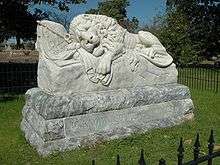Lion Monument
The Lion Monument (German: Löwendenkmal), or the Lion of Lucerne, is a rock relief in Lucerne, Switzerland, designed by Bertel Thorvaldsen and hewn in 1820–21 by Lukas Ahorn. It commemorates the Swiss Guards who were massacred in 1792 during the French Revolution, when revolutionaries stormed the Tuileries Palace in Paris. It is one of the most famous monuments in Switzerland, visited annually by about 1.4 million tourists.[1] In 2006 it was placed under Swiss monument protection.[2]


Mark Twain praised the sculpture of a mortally wounded lion as "the most mournful and moving piece of stone in the world."[3]
Background
From the early 17th century, a regiment of Swiss Guards had served as part of the Royal Household of France. On 6 October 1789, King Louis XVI had been forced to move with his family from the Palace of Versailles to the Tuileries Palace in Paris. In June 1791 he tried to flee to Montmédy near the frontier, where troops under royalist officers were concentrated. In the 1792 10th of August Insurrection, revolutionaries stormed the palace. Fighting broke out spontaneously after the Royal Family had been escorted from the Tuileries to take refuge with the Legislative Assembly. The Swiss Guards ran low on ammunition and were overwhelmed by superior numbers. A note written by the King half an hour after firing had commenced has survived, ordering the Swiss to retire and return to their barracks.[4] Delivered in the middle of the fighting, this was only acted on after their position had become untenable.[5]
Of the Swiss Guards defending the Tuileries, more than six hundred were killed during the fighting or massacred after surrender. An estimated two hundred more died in prison of their wounds or were killed during the September Massacres that followed. Apart from about a hundred Swiss who escaped from the Tuileries, the only survivors of the regiment were a 300 strong detachment which, with the King's authorization, had been sent to Normandy to escort grain convoys a few days before August 10.[6] The Swiss officers were mostly amongst those massacred, although Major Karl Josef von Bachmann — in command at the Tuileries — was formally tried and guillotined in September, still wearing his red uniform coat. Two surviving Swiss officers achieved senior rank under Napoleon.
Memorial
The initiative to create the monument was taken by Karl Pfyffer von Altishofen, an officer of the Guards who had been on leave in Lucerne at that time of the fight. He began collecting money in 1818. The monument was designed by Danish sculptor Bertel Thorvaldsen, and hewn in 1820–21 by Lukas Ahorn, in a former sandstone quarry near Lucerne. Carved into the cliff face, the monument measures ten metres in length and six metres in height.
The monument is dedicated Helvetiorum Fidei ac Virtuti ("To the loyalty and bravery of the Swiss"). The dying lion is portrayed impaled by a spear, covering a shield bearing the fleur-de-lis of the French monarchy; beside him is another shield bearing the coat of arms of Switzerland. The inscription below the sculpture lists the names of the officers and gives the approximate numbers of soldiers who died (DCCLX = 760), and survived (CCCL = 350).[7]
The monument is described by Thomas Carlyle in The French Revolution: A History.[8] The pose of the lion was copied in 1894 by Thomas M. Brady (1849–1907)[9] for his Lion of Atlanta in the Oakland Cemetery in Atlanta, Georgia.
Mark Twain on the monument
The Lion lies in his lair in the perpendicular face of a low cliff—for he is carved from the living rock of the cliff. His size is colossal, his attitude is noble. His head is bowed, the broken spear is sticking in his shoulder, his protecting paw rests upon the lilies of France. Vines hang down the cliff and wave in the wind, and a clear stream trickles from above and empties into a pond at the base, and in the smooth surface of the pond the lion is mirrored, among the water-lilies.
Around about are green trees and grass. The place is a sheltered, reposeful woodland nook, remote from noise and stir and confusion—and all this is fitting, for lions do die in such places, and not on granite pedestals in public squares fenced with fancy iron railings. The Lion of Lucerne would be impressive anywhere, but nowhere so impressive as where he is.— Mark Twain, A Tramp Abroad, 1880
References in literature
_02.jpg)
In The Chalet School Does It Again (1955) Elinor Brent-Dyer describes the monument, its history and the associated chapel.
In The Lions of Lucerne (2002) author Brad Thor describes the monument and the Swiss Guard it commemorates.
In her New Yorker tribute "My Buddy" (2017), Patti Smith reflects upon the death of Sam Shepard while standing in front of and addressing the monument.
Notes
- Lion Monument. "Lucerne Tourism". Lucerne Tourism. Retrieved 2019-07-04.
- "Löwendenkmal". Sehenswürdigkeiten von Luzern. 2015-06-08. Retrieved 2019-07-04.
- Mark Twain (1880). "Chapter XXVI: The Nest of the Cuckoo-Clock". A Tramp Abroad. Archived from the original on 2003-04-27. Retrieved 2008-08-08.
- Philip Mansel, page 131, Pillars of Monarchy ISBN 0 7043 2424 5
- M.J. Sydenham, page 111, The French Revolution, B.T. Batsford Ltd London 1965
- Jerome Bodin, page 259, "Les Suisses au Service de la France", ISBN 2-226-03334-3
- "Lion Monument Inscriptions". Glacier Garden, Lucerne. Archived from the original on 2011-07-06. Retrieved 2008-08-08.
- Thomas Carlyle, The French Revolution: A History, 498 (The Modern Library, New York, 2002).
- "Thomas M. Brady, Sr". Find A Grave. 2003-09-16. Retrieved 2008-08-09.
External links
| Wikimedia Commons has media related to Löwendenkmal (Lucerne). |
- Lion Monument, Lucerne, All About Switzerland travelguide. Retrieved on 2008-08-08.
- Dying Lion (The Lucerne Lion), The Thorvaldsen's Museum archives. Retrieved on 04-08-2017.